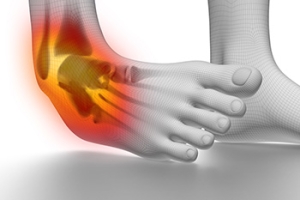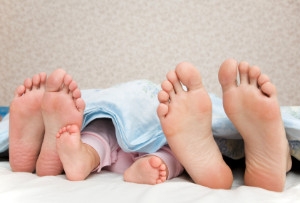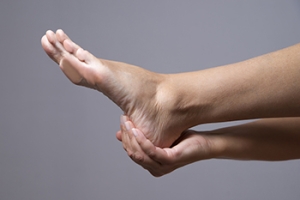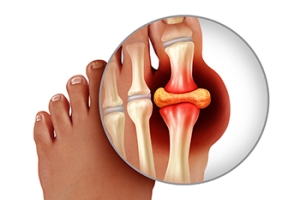Connect With Us
Blog

Risk Factors for Lateral Ankle Sprains

Lateral ankle sprains can happen to anyone as the result of a sudden movement, such as stepping off a curb and landing the wrong way. Ankle sprains are particularly common among athletes who engage in sudden stops and starts, jumping, or sideways movements. The majority of sprained ankles happen when the outer, or lateral, ligaments are stretched too much. Factors such as gender, height, and foot anatomy can contribute to vulnerability, as do previous injuries and improper footwear choices. Women wearing high heels, for instance, may be at higher risk of ankle sprains. A podiatrist can evaluate the severity of the sprain, identify underlying risk factors, and devise a personalized treatment plan for you. This foot doctor addresses both intrinsic and extrinsic factors of an ankle sprain. Treatment and a full recovery can help to minimize the risk of future ankle sprains. If you have sprained an ankle, it is suggested that you schedule an appointment with a podiatrist.
Although ankle sprains are common, they aren’t always minor injuries. If you need your ankle injury looked at, contact Howard Kimmel, DPM from Buckeye Foot Care. Our doctor can provide the care you need to keep you pain-free and on your feet.
How Does an Ankle Sprain Occur?
Ankle sprains are the result of a tear in the ligaments within the ankle. These injuries may happen when you make a rapid shifting movement while your foot is planted. A less common way to sprain your ankle is when your ankle rolls inward while your foot turns outward.
What Are the Symptoms?
- Pain at the sight of the tear
- Bruising/Swelling
- Ankle area is tender to touch
- In severe cases, may hear/feel something tear
- Skin discoloration
Preventing a Sprain
- Wearing appropriate shoes for the occasion
- Stretching before exercises and sports
- Knowing your limits
Treatment of a Sprain
In many cases, the RICE method (Rest, Ice, Compression, and Elevate) is used to treat ankle sprains. However, you should see a podiatrist to see which treatment option would work best with your injury. In severe cases, surgery may be required.
It is important to ask your doctor about rehab options after you receive treatment for your injury. Stretching, strength training, and balance exercises may help the ankle heal while also preventing further injury.
If you have any questions, please feel free to contact one of our offices located in Brook Park and Willoughby, OH . We offer the newest diagnostic and treatment technologies for all your foot care needs.
Three Grades of Ankle Sprains
An ankle sprain occurs when one or more ankle ligament gets overly stretched. Ligaments are strong bands of tissue that bind and support the bones and other structures that make up the ankle. In more severe ankle sprains, the ligament(s) tear—either partially or completely—and there may be an audible popping noise at the moment of injury.
Ankle sprains are quite common and can occur when the ankle rolls outwardly (eversion) or inwardly (inversion), causing the ligament(s) to stretch beyond normal limits, or even tear. Falls, twists, or blows to the ankle during sports or other activities can cause this injury, as well as wearing improper footwear, running on uneven surfaces, or having weak ankles.
Depending on the injury’s severity, an ankle sprain will be classified as Grade I, Grade II, or Grade III. Grade I sprains involve ligament(s) being overly stretched but not torn, with symptoms of mild pain, swelling, and ankle instability. There may also be some difficulty bearing weight. A Grade II sprain usually involves a partial tear of the ligament which brings more intensity in these symptoms, along with possible bruising. With a Grade III sprain, the ligament is completely torn, the symptoms are severe, and it may not be possible to put weight on the affected foot at all.
To diagnose and grade an ankle sprain, a podiatrist will perform a physical examination, checking for tenderness and range of motion in the ankle. For more severe sprains, X-rays or other imaging studies may be necessary.
It is vitally important to have an ankle sprain treated properly as improper healing often leads to future ankle sprains and possibly even chronic ankle stability. Treatment for an ankle sprain will vary, depending on its severity, and may include the RICE method (Rest/Ice/Compression/Elevation), physical therapy, bracing, medications, and possibly even surgery to repair a torn ligament. Rehabilitation is very important for the sprain to heal properly and to restore functionality.
Children’s Foot and Heel Pain Causes
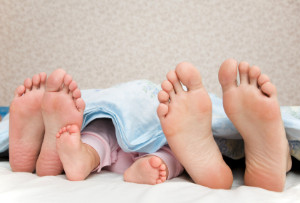 Children's foot and heel pain, or CFHP, encompasses a variety of conditions that can impact children’s ability to engage in activities and sports without discomfort. One common cause of CFHP is Sever's disease, a condition that results from inflammation of the growth plate in the heel. Sever’s disease is often seen in active children undergoing growth spurts. Additionally, flat feet or overpronation can strain the foot's muscles and ligaments, causing pain. Improper footwear, intense physical activity, and obesity may also contribute to the development of CFHP. Symptoms typically include pain in the foot or heel, particularly during or after physical activities, and might be accompanied by swelling or redness. Addressing CFHP involves a combination of rest, wearing appropriate footwear, and sometimes orthotic devices to support the foot's structure. Early diagnosis and treatment are important to prevent chronic problems and ensure that children can participate in their favorite activities without pain. If your child is suffering with foot or heel pain, it is suggested that you schedule an appointment with a podiatrist today.
Children's foot and heel pain, or CFHP, encompasses a variety of conditions that can impact children’s ability to engage in activities and sports without discomfort. One common cause of CFHP is Sever's disease, a condition that results from inflammation of the growth plate in the heel. Sever’s disease is often seen in active children undergoing growth spurts. Additionally, flat feet or overpronation can strain the foot's muscles and ligaments, causing pain. Improper footwear, intense physical activity, and obesity may also contribute to the development of CFHP. Symptoms typically include pain in the foot or heel, particularly during or after physical activities, and might be accompanied by swelling or redness. Addressing CFHP involves a combination of rest, wearing appropriate footwear, and sometimes orthotic devices to support the foot's structure. Early diagnosis and treatment are important to prevent chronic problems and ensure that children can participate in their favorite activities without pain. If your child is suffering with foot or heel pain, it is suggested that you schedule an appointment with a podiatrist today.
Making sure that your children maintain good foot health is very important as they grow. If you have any questions, contact Howard Kimmel, DPM of Buckeye Foot Care. Our doctor can provide the care you need to keep you pain-free and on your feet.
Keeping Children's Feet Healthy
Having healthy feet during childhood can help prevent medical problems later in life, namely in the back and legs. As children grow, their feet require different types of care. Here are some things to consider...
Although babies do not walk yet, it is still very important to take care of their feet.
Avoid putting tight shoes or socks on his or her feet.
Allow the baby to stretch and kick his or her feet to feel comfortable.
As a toddler, kids are now on the move and begin to develop differently. At this age, toddlers are getting a feel for walking, so don’t be alarmed if your toddler is unsteady or ‘walks funny’.
As your child gets older, it is important to teach them how to take care of their feet.
Show them proper hygiene to prevent infections such as fungus.
Be watchful for any pain or injury.
Have all injuries checked by a doctor as soon as possible.
Comfortable, protective shoes should always be worn, especially at play.
If you have any questions please feel free to contact one of our offices located in Brook Park and Willoughby, OH . We offer the newest diagnostic and treatment technologies for all your foot and ankle needs.
What to Do to Keep Your Child’s Feet Healthy
Being a parent involves caring for your child in every way you can. You make sure they are eating the right food, being nice to others, and staying out of any trouble. However, it is also important that you are watchful of their health, more specifically their foot health. Maintaining good foot health in childhood is important in preventing later conditions in life from happening. As children continue to develop, their feet require different techniques of care. Here are some various ways in which you can help your child’s feet stay healthy.
A baby needs a lot of care and attention overall, but the importance of their feet should never be forgotten. Before a baby turns one, their feet change and develop greatly. It is important that during this time, a mother avoids putting tight socks on their child. She should also encourage movement of their feet so the baby can begin to feel more comfortable using them.
As a baby enters the toddler years of his or her life, they are begin to walk around. When your baby begins to take those first steps, it is crucial that they are wearing protective shoes on their feet. As a mother that is observant of your child’s feet, you may notice changes in them. This is completely normal as the feet are becoming susceptible to the activity of walking. It is normal for a toddler to be a bit unsteady or to “walk funny” at first.
When your child grows out of their toddler years, it is important that you begin to show him or her how to care for their feet on their own. Practice with your child proper hygiene in order to prevent foot fungus or infection. Since children are constantly on the move, it is crucial to be cautious of any accidents or injuries that might occur. If an injury occurs, it is advised that you take your child to be examined by a doctor immediately. Since your child is still growing, particular injuries can shift the way in which a bone or other important part of the foot is developing.
Babies and kids are always changing and growing. Your job as a parent is to make sure they stay healthy and making sure they are properly maintained. This involves proper foot care and making sure the feet stay healthy. Following this guide, your child can live a long and happy life.
Lump in the Foot Arch and Plantar Fibroma
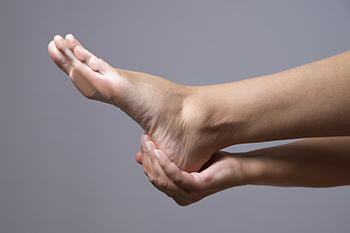 Plantar fibroma is a benign condition characterized by the formation of a knot or nodule in the arch of the foot. This lump occurs in the plantar fascia, which is a thick band of tissue that runs from the heel to the toes. Typically, someone can feel it if they physically examine the foot. A plantar fibroma can develop in one or both feet, and it usually remains stable in size or grows slowly over time. The lump in the arch may or may not be painful. When pain is present, it's often because the fibroma presses against footwear or the ground, creating pressure on the foot. This discomfort can be increased by standing, walking, or wearing tight or unsupportive shoes. People sometimes modify their gait or posture in an attempt to minimize discomfort, which potentially causes secondary pain in the feet, legs, or back. Treatment options vary depending on the severity of symptoms. Conservative options may include orthotic devices and footwear modifications, and more invasive procedures may involve steroid injections or surgery. If you have a lump in the arch of the foot and suspect a plantar fibroma, it is suggested that you make an appointment with a podiatrist for diagnosis and treatment options.
Plantar fibroma is a benign condition characterized by the formation of a knot or nodule in the arch of the foot. This lump occurs in the plantar fascia, which is a thick band of tissue that runs from the heel to the toes. Typically, someone can feel it if they physically examine the foot. A plantar fibroma can develop in one or both feet, and it usually remains stable in size or grows slowly over time. The lump in the arch may or may not be painful. When pain is present, it's often because the fibroma presses against footwear or the ground, creating pressure on the foot. This discomfort can be increased by standing, walking, or wearing tight or unsupportive shoes. People sometimes modify their gait or posture in an attempt to minimize discomfort, which potentially causes secondary pain in the feet, legs, or back. Treatment options vary depending on the severity of symptoms. Conservative options may include orthotic devices and footwear modifications, and more invasive procedures may involve steroid injections or surgery. If you have a lump in the arch of the foot and suspect a plantar fibroma, it is suggested that you make an appointment with a podiatrist for diagnosis and treatment options.
A plantar fibroma may disrupt your daily activities. If you have any concerns, contact Howard Kimmel, DPM of Buckeye Foot Care. Our doctor can provide the care you need to keep you pain-free and on your feet.
Plantar Fibroma
A plantar fibroma is a fibrous knot in the arch of the foot. It is embedded in the plantar fascia which is a band of tissue that extends from the heel to the toes along the bottom of the foot. There can be multiple plantar fibromas in the feet at the same time. There are no known causes for this condition. If you have a plantar fibroma, there will be a bump in the arch of your foot that cannot be missed. Any associated pain is most often due to a shoe rubbing against the nodule. Non-surgical options, such as steroid injections, physical therapy, and orthotics should be tried first. Surgery is a last resort and is the only thing that will remove a plantar fibroma entirely. Consult with a podiatrist for a proper diagnosis and to determine the treatment regimen that is right for you.
What Causes a Plantar Fibroma?
While there are no specific causes identified, a plantar fibroma can possibly come from genetic predisposition or the formation of scar tissue that forms from healing the tears in the plantar fascia.
What Are the Symptoms of a Plantar Fibroma?
There will be a noticeable lump in the arch of the foot that may or may not cause pain. If pain is felt, it is typically because a shoe is rubbing up against the lump or when walking or standing barefoot.
Treatment and Prevention
A plantar fibroma will not disappear without treatment, but it can get smaller and be a non-issue. If pain persists, a podiatrist examines the foot and when the arch of the foot is pressed, pain can be felt down to the toes. An MRI or biopsy might be performed to help diagnose or evaluate the plantar fibroma. The following non-surgical options are generally enough to reduce the size and pain of these nodules:
- Steroid injections
- Orthotics
- Physical therapy to help apply anti-inflammatory creams on the bump
Surgery is considered if the mass increases in size and the patient continues to feel pain after non-surgical methods are tried.
If you have any questions please feel free to contact one of our offices located in Brook Park and Willoughby, OH . We offer the newest diagnostic tools and technology to treat your foot and ankle needs.
Plantar Fibroma
A plantar fibroma is a knot in the arch of the foot. It can cause pain when repeated pressure is applied by walking barefoot or wearing tight shoes. While plantar fibromas can appear in anyone, men who are middle-aged or older are said to be more susceptible. The main symptom of a plantar fibroma is a firm lump on the arch of the foot. If there is pain, it can be intensified by putting pressure on the nodule. The lump can stay one size or grow larger. You may have one or more fibromas in the feet and there tends to be a high incidence of recurring plantar fibromas. Generally, a plantar fibroma can be treated without surgery. Treatment might include steroid injections to help shrink the lump, orthotics to help redistribute weight away from the nodule, plantar fascia stretching, or physical therapy to help use anti-inflammatory medication on the lump. If a lump grows larger or more painful, a podiatrist can be consulted to confirm the diagnosis. The doctor will palpate the lump and this may cause pain that can be felt all the way to the toes. An X-ray, MRI, or biopsy might be done if further evaluation is necessary. A lump in the arch of the foot might be something other than a plantar fibroma, such as cysts, nerve or fatty tumors, swollen tendons, or an infection in the foot. It is important to see a podiatrist for proper diagnosis and treatment of plantar fibromas.
Various Ways of Testing for Gout
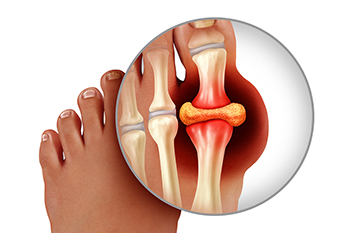
Gout, a painful form of arthritis, often causes intense swelling in a single joint, typically the big toe. Gout is the result of high levels of uric acid in the blood. The uric acid forms crystals in the joints that result in sudden and severe pain, called flare ups. Diagnostic lab tests for gout examine blood or joint fluid for uric acid levels or crystals, though not all cases show elevated uric acid levels. Imaging tests like X-rays, ultrasounds, or special CT scans can help show joint damage or uric acid crystals. Monitoring lab tests can track uric acid levels over time, with additional assessments of kidney function through creatinine and blood urea nitrogen, or BUN, tests. A urinalysis is used to detect uric acid in urine. Regular imaging tests monitor joint health to detect any damage caused by untreated gout. A podiatrist can conduct the appropriate diagnostic tests for gout. If you are experiencing toe joint pain or suspect gout, it is suggested that you schedule an appointment with a podiatrist.
Gout is a painful condition that can be treated. If you are seeking treatment, contact Howard Kimmel, DPM from Buckeye Foot Care. Our doctor will treat your foot and ankle needs.
What Is Gout?
Gout is a form of arthritis that is characterized by sudden, severe attacks of pain, redness, and tenderness in the joints. The condition usually affects the joint at the base of the big toe. A gout attack can occur at any random time, such as the middle of the night while you are asleep.
Symptoms
- Intense Joint Pain - Usually around the large joint of your big toe, and it most severe within the first four to twelve hours
- Lingering Discomfort - Joint discomfort may last from a few days to a few weeks
- Inflammation and Redness -Affected joints may become swollen, tender, warm and red
- Limited Range of Motion - May experience a decrease in joint mobility
Risk Factors
- Genetics - If family members have gout, you’re more likely to have it
- Medications - Diuretic medications can raise uric acid levels
- Gender/Age - Gout is more common in men until the age of 60. It is believed that estrogen protects women until that point
- Diet - Eating red meat and shellfish increases your risk
- Alcohol - Having more than two alcoholic drinks per day increases your risk
- Obesity - Obese people are at a higher risk for gout
Prior to visiting your podiatrist to receive treatment for gout, there are a few things you should do beforehand. If you have gout you should write down your symptoms--including when they started and how often you experience them, important medical information you may have, and any questions you may have. Writing down these three things will help your podiatrist in assessing your specific situation so that he or she may provide the best route of treatment for you.
If you have any questions, please feel free to contact one of our offices located in Brook Park and Willoughby, OH . We offer the newest diagnostic and treatment technologies for all your foot care needs.
Gout
Gout is a form of arthritis that is caused by a buildup of uric acid crystals in the joints. This considered to be one of the most frequently recorded medical illnesses throughout history. Gout occurrences in the US have risen within the past twenty years and the condition now affects 8.3 million people which is 4% of all Americans. Researchers have found that gout affects men more than women and African-American men more than white men.
Symptoms of gout are warmth, swelling, discoloration, and tenderness in the affected joint area. The small joint on the big toe is the most common place for a gout attack to occur.
People who are obese, gain weight excessively, drink alcohol heavily, have high blood pressure, or have abnormal kidney function are more likely to develop gout. Furthermore, certain drugs and diseases are likely to increase levels of uric acid in the joints which eventually leads to gout. You are also more likely to develop gout if you eat a lot of meat and fish.
Many who experience gout attacks will experience repeated attacks over the years. Some people who have gout symptoms, may never have them again, but others may experience them several times a year. If you have gout symptoms throughout the year, you may have recurrent gout. Those who have gout should also be careful about their urate crystals collecting in their urinary tract, because this may lead to kidney stones.
Diagnosis for gout is done by checking the level of uric acid in the joints and blood. Your podiatrist may also prescribe medicine to reduce uric acid buildup in the blood, which will help prevent any gout attacks.
To treat gout, your podiatrist may also prescribe you Anti-inflammatory medication (NSAIDs) which will relieve the pain and swelling of a gout episode and it can also shorten a gout attack. Maintaining a healthy diet is also a proven method to prevent gout attacks.
Preventing Hammertoe
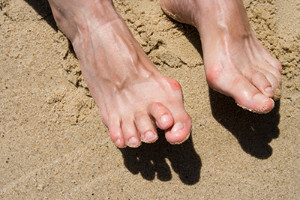
If one of your toe joints points upward instead of lying flat, it might indicate a condition known as hammertoe, where weakened toe muscles exert pressure on tendons and joints. This deformity can hinder walking and limit certain activities. Early intervention and preventive measures can help to avoid complications. Hammertoes affect the proximal interphalangeal joint, or PIPJ, causing the middle joint to flex upward. Ill-fitting shoes, especially those with narrow fronts or high heels, commonly trigger this condition. Rheumatoid arthritis or bunions can also contribute. Treatment includes wearing properly sized shoes and using splints or orthotic inserts. Surgery may be necessary for severe cases. Home exercises like toe stretches can help alleviate symptoms. Prioritize footwear comfort to prevent hammertoes and bunions from forming due to prolonged pressure on the toes. If you have a hammertoe that is causing you discomfort, it is suggested that you make an appointment with a podiatrist for an examination and relief methods.
Hammertoe
Hammertoes can be a painful condition to live with. For more information, contact Howard Kimmel, DPM from Buckeye Foot Care. Our doctor will answer any of your foot- and ankle-related questions.
Hammertoe is a foot deformity that affects the joints of the second, third, fourth, or fifth toes of your feet. It is a painful foot condition in which these toes curl and arch up, which can often lead to pain when wearing footwear.
Symptoms
- Pain in the affected toes
- Development of corns or calluses due to friction
- Inflammation
- Redness
- Contracture of the toes
Causes
Genetics – People who are genetically predisposed to hammertoe are often more susceptible
Arthritis – Because arthritis affects the joints in your toes, further deformities stemming from arthritis can occur
Trauma – Direct trauma to the toes could potentially lead to hammertoe
Ill-fitting shoes – Undue pressure on the front of the toes from ill-fitting shoes can potentially lead to the development of hammertoe
Treatment
Orthotics – Custom made inserts can be used to help relieve pressure placed on the toes and therefore relieve some of the pain associated with it
Medications – Oral medications such as anti-inflammatories or NSAIDs could be used to treat the pain and inflammation hammertoes causes. Injections of corticosteroids are also sometimes used
Surgery – In more severe cases where the hammertoes have become more rigid, foot surgery is a potential option
If you have any questions please contact one of our offices located in Brook Park and Willoughby, OH . We offer the newest diagnostic and treatment technologies for all your foot and ankle needs.
